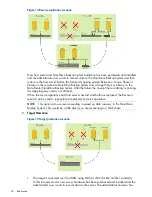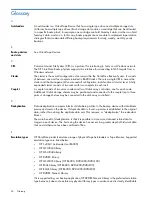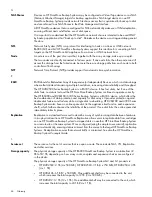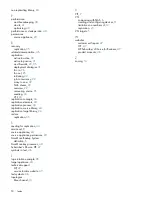
as a StoreOnce device. It is the most flexible emulation type available; however, backup
application support varies by software vendor.
F
Fibre Channel (FC)
Fibre Channel (FC) supports network connectivity over fibre optic cabling or copper wiring. FC
has a different set of standards and network connection protocol to Ethernet and different
configuration requirements. FC HP StoreOnce Backup Systems may be connected to both a Fibre
Channel SAN and an Ethernet (as an iSCSI device) network. The FC connection is used only to
transfer backup data from the host to the HP StoreOnce Backup System. Access to the HP
StoreOnce Web Management Interface is always across an Ethernet connection.
Flexible emulation
Flexible emulation does not set hard limits on the number of VTL devices (loader and drives) and
NAS shares that may be configured for a particular data store, although there are restrictions on
the maximum numbers that may be configured for an appliance. This allows the user to balance
performance against deduplication ratio when deciding how backup streams from the host will
be configured. See also
Flexible emulation (page 13)
.
H
Hosts
A server that is being used to back up to the StoreOnce system via iSCSI or Fibre Channel, this
may also be a backup application media server which can back up other servers on the network
that do not have a direct iSCSI or Fibre Channel connection to the StoreOnce Backup System.
Housekeeping
If data is deleted from the StoreOnce Backup System (e.g a virtual cartridge is overwritten or
erased), any unique chunks will be marked for removal, any non-unique chunks are de-referenced
and their reference count decremented. The process of removing chunks of data is not an inline
operation because this would significantly impact performance. This process, termed
“housekeeping”, runs on the appliance as a background operation, it runs on a per cartridge
and NAS file basis and will run as soon as the cartridge is unloaded and returned to its storage
slot or a NAS file has completed writing and has been closed by the appliance.
I
iSCSI (not available
with B6000)
On an Ethernet network the HP StoreOnce Backup System is configured as an iSCSI device. This
means that the HP StoreOnce Backup System plugs directly into the network, but it presents devices
as directly-attached SCSI libraries to host machines. In order to function, it requires an iSCSI
initiator. For more information about iSCSI, see the HP StoreOnce Backup System Installation
and Configuration Guide. Linux and UNIX users should also refer to the Linux and UNIX
Configuration Guide on the HP StoreOnce Backup System CD-ROM for more information.
L
Library
library is a Virtual Tape Device that appears to the backup application on the host as a physical
tape library. A tape library is a backup device that has multiple drives and multiple storage slots.
Each storage slot contains a cartridge. This provides considerable storage capacity and full
support for tape rotation strategies. The difference between an autoloader and a library is that
a library can support multiple tape drives whereas an autoloader only has one tape drive. (It
may be necessary to upgrade your backup application to support libraries.)
M
Mail slots
(import/export
elements)
A mail slot is a term borrowed from tape terminology to identify a dedicated slot that is used
specifically to import and export cartridges. They are sometimes called import/export elements
by backup applications. Backup applications that support this feature move cartridges from the
mail slot when the user runs an Export job, and look for cartridges in the mail slot when the user
runs an Import job.
Mail slots have no practical usage with G3 (B6000) and G2 HP StoreOnce Backup Systems
because direct export to tape is not supported.
43








































